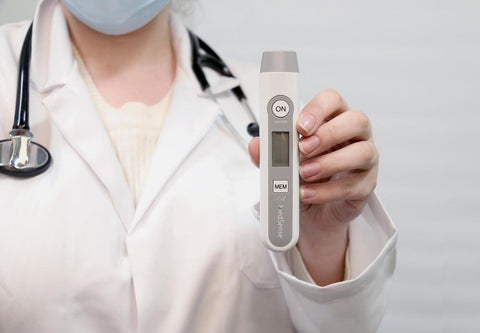With the recent coronavirus issue, more and more people have opted for a non-invasive form of temperature testing to reduce contact (and also potentially reduce transmission of viruses) between one another. Luckily, the non-contact infrared thermometer fit the bill perfectly- with its ability to rapidly test individuals, and reducing actual contact between parties, the non-contact IR thermometer is a handy tool to have for any business, home, school, mall, etc.
So how does an IR thermometer actually work? Well, although the technology used within IR thermometers are generally complex, the concept is relatively simple: anything that has mass emits some degree of energy, regardless of size. This temperature is emitted in the form of heat- as heat is emitted from objects, the infrared thermometer utilises the difference between the light rays being emitted from an object and the surrounding environment so that it can determine the temperature of the object being measured.
Infrared light operates similarly to visible light (or rather, light that is on the electromagnetic spectrum that is visible to the human eye)- it can be absorbed, focused, and reflected. Infrared thermometers typically utilise a lens to focus infrared light from an object onto a detector called a thermopile. Within the thermopile, the IR radiation is then turned into heat which is then turned to electricity, and finally measured. The reading will be generated in a matter of seconds, meaning an infrared thermometer is a quick way to gather a temperature reading in a number of different scenarios.
According to the FDA, there are specific guidelines to follow when using non-contact IR thermometers- they are as follows: “1. The test area of the forehead is clean, dry and not blocked during measurement. 2. The person’s body temperature or temperature at the forehead test area has not been increased or decreased by wearing excessive clothing or head covers (for example headbands, bandanas), or by using facial cleansing products (for example cosmetic wipes). 3. Hold the NCIT sensing area perpendicular to the forehead and instruct the person to remain stationary during measurement(s). 4. The distance between the NCIT and forehead is specific to each NCIT. Consult the manufacturer’s instructions for correct measurement distances. 5. Do not touch the sensing area of the NCIT and keep the sensor clean and dry.
If you’re interested in purchasing an infrared thermometer, do have a look at our MedSense Non-Contact Infrared Thermometer, or give us a call at 1300 800 200 for further information/ enquiries.
References:
- Non-contact Infrared Thermometers: https://www.fda.gov/medical-devices/general-hospital-devices-and-supplies/non-contact-infrared-thermometers
- Non-Contact Thermometers for Detecting Fever: A Review of Clinical Effectiveness: https://www.ncbi.nlm.nih.gov/books/NBK263237/
- How Do Infrared Thermometers Work?: https://sciencing.com/infrared-thermometers-work-4965130.htm
- Non-Contact Infrared Thermometers: https://www.community.healthcare.mic.nihr.ac.uk/reports-and-resources/horizon-scanning-reports/hs-report-0025






